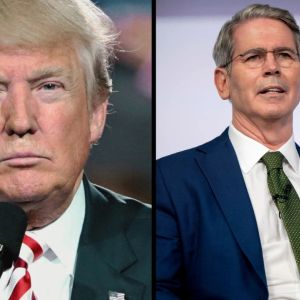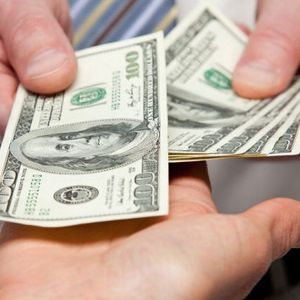President Donald Trump has moved ahead with a new set of sweeping tariffs, prompting Treasury Secretary Scott Bessent to urge foreign governments against hitting back with retaliatory measures. Bessent, speaking Wednesday to Bloomberg Television, said, “I wouldn’t try to retaliate. As long as you don’t retaliate this is the high end of the number.” His comments came shortly after Trump unveiled a minimum 10% tariff on all exporters to the United States, plus additional duties on about 60 nations with the biggest trade imbalances with the US. The 10% tariff would take effect at midnight Saturday, followed by the higher, customized duties by 12:01 a.m. on April 9. According to the administration’s plan, certain partners are now facing far steeper penalties. China was singled out for a tariff of at least 54% on many goods. The European Union, Vietnam, and other major exporters will also see rates above 10% when the policy goes into effect. Bessent suggested these levels might stay where they are if other governments avoid countermeasures: “This is the high end of the number barring retaliation,” he said. “As far as negotiations go—we’ll see.” Trump during the speech on “Liberation Day”. Source: Fox 5 Atlanta Those existing tariffs will remain. Neither country will be subject to the new tariff schedule as long as the current measures stay in force. Products covered by the USMCA agreement, which Trump negotiated in his first term, will remain exempt. The president has long argued that tariffs can be used to restore American manufacturing strength and protect US businesses, even though many economists fear this approach could set off rounds of retaliation. After World War II, the US and allies worked for decades to reduce duties and encourage trade, viewing international commerce as a safeguard against future conflicts. Trump’s latest move goes in the other direction, raising the prospect of higher costs for importers and possible retaliation by foreign capitals. The stock market responded quickly to the announcements According to Bloomberg’s report , major stock benchmarks lost at least 2% in the hours after the announcement, as investors and traders had been hoping for a less severe plan. Automaker shares slid in after-hours trading in New York before recovering some ground, while crude oil prices in New York opened around 2% lower. Analysts pointed out that the US relies on oil imports from Europe for its East Coast refineries, though it also exports some crude to other countries. Mary Lovely, a senior fellow at the Peterson Institute for International Economics, expressed alarm at the scale of the administration’s move. She called the new tariffs “much worse than we feared” and warned of major consequences for how goods flow around the globe. Questions remain about how the new rates will actually be administered. China bears the heaviest burden, while Canada and Mexico are exempted from additional tariffs On top of the 34% levy tied to Trump’s “reciprocal” plan, China already faces a 20% tariff due to fentanyl trafficking, as well as separate duties on items such as solar panels. Combined, these surcharges mean many imports from China could exceed a 50% duty. Trump has claimed those numbers are still not fully “reciprocal,” though the administration has not explained in detail how it arrived at the 54% figure. Bloomberg Economics estimates suggest that a 54% rate could cut China’s exports to the US by up to 90% by 2030. The European Union, according to White House documents, will face a 20% tariff. and Vietnam’s figure is set at 46%. Other countries singled out for higher rates include Japan at 24%, South Korea at 25%, India at 26%, Cambodia at 49%, and Taiwan at 32%. BREAKING: U.S. REVEALS RECIPROCAL TARIFF RATES LIST pic.twitter.com/52bCf73wuU — DEGEN NEWS (@DegenerateNews) April 2, 2025 Canada and Mexico, the two neighbors, appear safe from the latest list for now because of the already existing 25% tariffs. In the event those measures are ended, any items not covered by USMCA provisions would see a 12% tariff. The White House statement made it clear that USMCA-compliant goods would remain free of the new levies. Trump called these tariffs “kind reciprocal,” saying that many foreign markets are still far more closed to US exports than America is to their goods. He also hinted that the US may lower its new tariffs if other countries reduce their own import barriers and stop what he calls currency manipulation. Administration officials have insisted that the tariffs will bring factories back to the US and generate job opportunities. Critics counter that the higher import costs will be painful for consumers and businesses. The president’s team, for its part, has asked the public to be patient, saying the final gains will outweigh any short-term problems. “We’ll see where it goes from here,” Bessent said, suggesting that any next steps would be slow. Other nations have signaled they are open to trade discussions, but the administration wants to “let things settle for a while” before deciding on its next move. Trump didn’t spare his ‘friend’ Modi’s government from tariffs India also got slapped with high tariff rates despite being a major US trading partner. Trump mentioned that he has good personal ties with India’s Prime Minister, and his ties didn’t affect the tariff outcome for India. The country is now facing a 25% tariff on imports, higher than the EU, Japan, and South Korea. However, it is certainly less than China and Vietnam. Nevertheless, these tariffs for India are a setback for the Indian government, which tried to dodge the tariffs by offering sweeping concessions on issues aligning with Trump’s agenda. Trump said at the White House earlier today, “India, very, very tough. Very, very tough.” He added, “The prime minister just left, and he’s a great friend of mine. But I said, you’re a friend of mine, but you’re not treating us right. They charge us 52%.” According to one Indian government official, it’s just a “mixed bag” and not really a setback for the country. Ajay Sahi, the director general at the Federation of Indian Export Organizations, said, “Our competitors like Vietnam and Cambodia have been hit harder than us.” He added, “solace in the fact that we are already engaged with the US” on a trade agreement. Cryptopolitan Academy: Want to grow your money in 2025? Learn how to do it with DeFi in our upcoming webclass. Save Your Spot
















